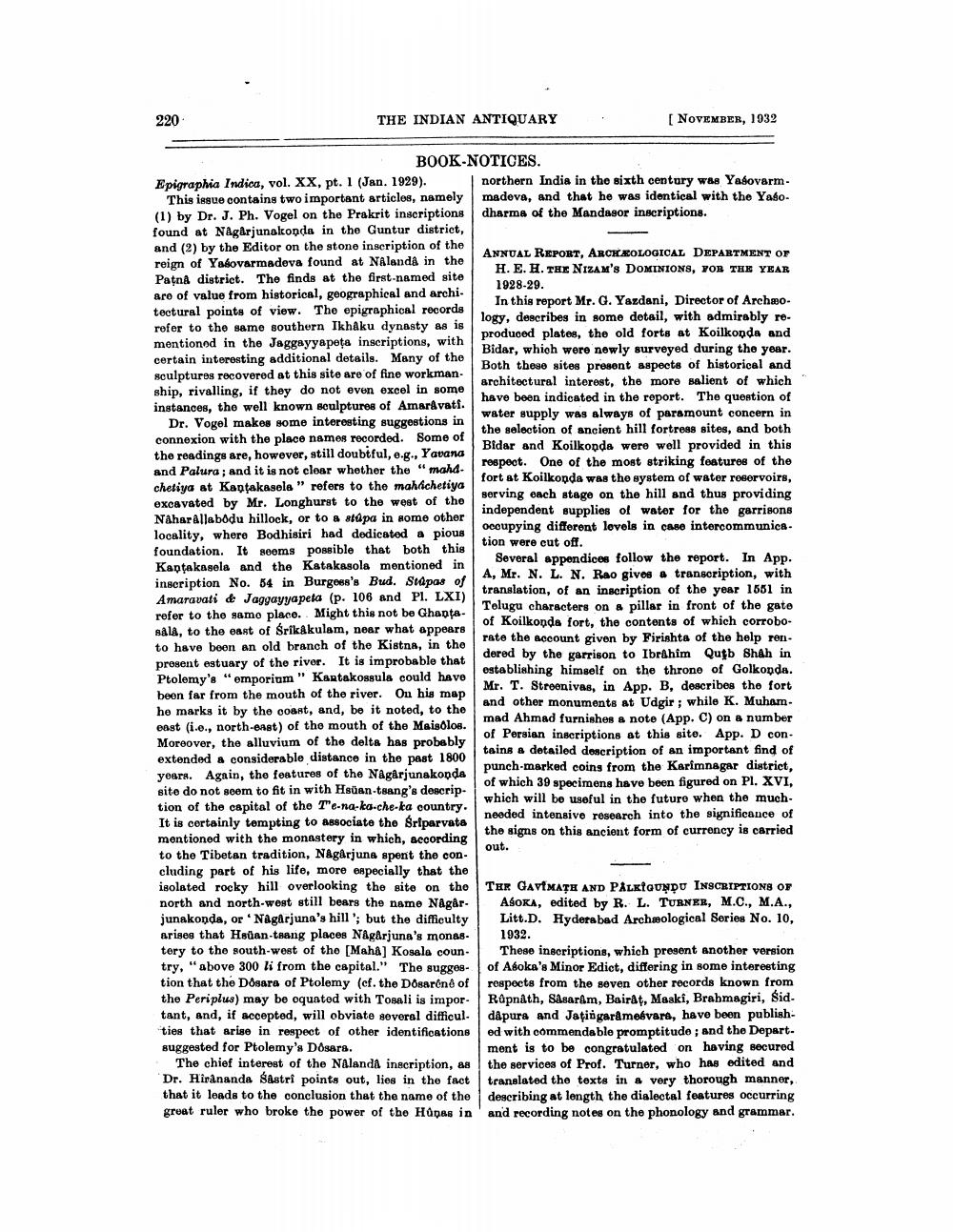________________
220
THE INDIAN ANTIQUARY
[ NOVEMBER, 1932
BOOK-NOTICES. Epigraphia Indica, vol. XX, pt. 1 (Jan. 1929). northern India in the sixth century was Yasovarm.
This issue contains two important articles, namely madova, and that he was identical with the Yaso. (1) by Dr. J. Ph. Vogel on the Prakrit inscriptions dharma of the Mandagor inscriptions. found at Nagarjunolonda in the Guntur district, and (2) by the Editor on the stone inscription of the
ANNUAL REPORT, ARCHEOLOGICAL DEPARTMENT OF reign of Yasovarmadeva found at NAland& in the
H.E.H. THE NIZAM'S DOMINIONS, FOR THE YEAR Patna district. The finds at the first-named site
1928-29. aro of value from historical, geographical and archi.
In this report Mr. G. Yazdani, Director of Archæo. tectural points of view. The epigraphical records
logy, describes in some detail, with admirably rerefer to the same southern Ikhaku dynasty as is
produoed plates, the old forts at Koilkonda and mentionod in the Jaggayyapeta inscriptions, with
Bidar, which were newly surveyed during the year. certain interesting additional details. Many of the
Both these sites present aspects of historical and sculptures recovered at this site are of fine workman.
architectural interest, the more salient of which ship, rivalling, if they do not even excel in some
have been indicated in the report. The question of instances, the well known sculptures of Amar&vati.
water supply was always of paramount concern in Dr. Vogel makes some interesting suggestions in
the selection of ancient hill fortrees sites, and both connexion with the place names recorded. Some of
Bidar and Koilkonda were well provided in this the readings are, however, still doubtful, e.g., Yavana
respect. One of the most striking features of the and Palura; and it is not clear whether the “maha.
fort at Koilkonda was the system of water reservoirs, chetiya at Kantakasela" refers to the mah chetiya excavated by Mr. Longhurst to the west of the
serving each stage on the hill and thus providing
independent supplies of water for the garrisons NaharAllabodu hillock, or to a stapa in some other
occupying different levels in case intercommunicalocality, where Bodhisiri had dedicatod a pious
tion were cut off. foundation. It seems possible that both this
Several appendices follow the report. In App. Kantakasela and the Katakasola mentioned in
A, Mr. N. L. N. Rao gives a transcription, with inscription No. 54 in Burgess's Bud. Sidpas of
translation, of an inscription of the year 1651 in Amaravati & Jaggayyapeta (p. 106 and PI. LXI)
Telugu characters on a pillar in front of the gate refer to the samo place. Might this not be Ghanta
of Koilkonda fort, the contents of which corrobosala, to the east of Srikakulam, near what appears
rate the account given by Firishta of the help rento have been an old branch of the Kistna, in the
dered by the garrison to Ibråhim Qutb Shah in prosent estuary of the river. It is improbable that
establishing himself on the throne of Golkonda. Ptolemy's "emporium " Kantakossula could have
Mr. T. Streenivas, in App. B, describes the fort been far from the mouth of the river. On his map
and other monuments at Udgir ; while K. Muham. he marks it by the coast, and, be it noted, to the
mad Ahmad furnishes & note (App. C) on a number east i.e., north-east) of the mouth of the Maisolos.
of Persian inscriptions at this site. App. D conMoreover, the alluvium of the delta has probably
tains a detailed description of an important find of extended a considerable distance in the past 1800
punch-marked coins from the Karimnagar district, years. Again, the features of the Nagarjunakonda
of which 39 specimens have been figured on Pl. XVI, site do not seem to fit in with Hsuan-tsang's descrip. tion of the capital of the T"e-na-ka-che-ka country.
which will be useful in the future when the much
needed intensive research into the significance of It is certainly tempting to associate the Sriparvata
the signs on this ancient form of currency is carried mentioned with the monastery in which, according to the Tibetan tradition, Nagarjuna spent the con.
out. cluding part of his life, more especially that the isolated rocky hill overlooking the site on the TER GAVIMATH AND PÅLKEGUNDU INSCRIPTIONS OF north and north-west still bears the name Nagår. ASOKA, edited by R. L. TURNER, M.C., M.A., junakonda, or Nagarjuna's hill '; but the difficulty Litt.D. Hyderabad Archeological Series No. 10, arisee that Hsüan-thang places Nagarjuna's monas- 1932. tory to the south-west of the [Maha) Kosala coun- These inscriptions, which present another version try, "above 300 li from the capital." The sugges- of Asoka's Minor Edict, differing in some interesting tion that the Dosara of Ptolemy (cf. the Dosarend of respects from the seven other records known from the Periplus) may be oquatod with Tosali is impor- Rûpnåth, Sasaram, Bairåt, Maski, Brabmagiri, Sid. tant, and, if accepted, will obviate several difficul. dåpura and Jațingarámesvara, have been publishties that arise in respect of other identifications ed with commendable promptitude ; and the Depart. suggested for Ptolemy's Dosars.
mont is to be congratulated on having secured The chief interest of the Nalanda inscription, as the services of Prof. Turner, who has edited and Dr. Hirananda Sastri points out, lies in the fact translated the texts in a very thorough manner, that it leads to the conclusion that the name of the describing at length the dialectal features occurring great ruler who broke the power of the Hapas in and recording notes on the phonology and grammar.




